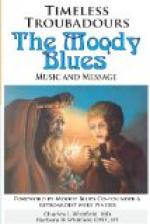This was Beatrice, Countess of Die and the wife of Count William of Poitiers. The names, at least, of seventeen poetesses are known to us and of these the Countess of Die is the most famous. Like the rest of her sex who essayed the troubadour’s art, the Countess knows nothing of difficult rhymes or obscurity of style. Simplicity and sincerity are the keynotes of her poetry. The troubadour sang because he was a professional poet, but the lady who composed poetry did so from love of the art or from the inspiration of feeling and therefore felt no need of meretricious adornment for her song. The five poems of the Countess which remain to us show that her sentiment for Raimbaut was real and deep. “I am glad to know that the man I love is the worthiest in the world; may God give great joy to the one who first brought me to him: [66] may he trust only in me, whatever slanders be reported to him: for often a man plucks the rod with which he beats himself. The woman who values her good name should set her love upon a noble and valiant knight: when she knows his worth, let her not hide her love. When a woman loves thus openly, the noble and worthy speak of her love only with sympathy.” Raimbaut, however, did not reciprocate these feelings: in a tenso with the countess he shows his real sentiments while excusing his conduct. He assures her that he has avoided her only because he did not wish to provide slanderers with matter for gossip; to which the Countess replies that his care for her reputation is excessive. Peire Rogier whose poetical career lies between the years 1160 and 1180, also spent some time at Raimbaut’s court. He belonged to Auvergne by birth and was attached to the court of Ermengarde of Narbonne for some years: here there is no doubt that we have a case of a troubadour in an official position and nothing more: possibly Peire Rogier’s tendency to preaching—he had been educated for the church—was enough to stifle any sentiment on the lady’s side. On leaving Narbonne, he visited Raimbaut at Orange and afterwards travelled to Spain and Toulouse, finally entering a monastery where he ended his life.
Auvergne produced a far more important troubadour in the person of Peire [67] d’Auvergne, whose work extended from about 1158 to 1180; he was thus more or less contemporary with Guiraut de Bornelh and Bernart de Ventadour. He was, according to the biography, the son of a citizen of Clermont-Ferrand, and “the first troubadour, who lived beyond the mountains (i.e. the Pyrenees, which, however, Marcabrun had previously crossed)... he was regarded as the best troubadour until Guiraut de Bornelh appeared.... He was very proud of his talents and despised other troubadours.” Other notices state that he was educated for an ecclesiastical career and was at one time a canon. He had no small idea of his own powers: “Peire d’Auvergne,” he says in his satire upon other troubadours “has such a voice that he can sing in all tones and his




